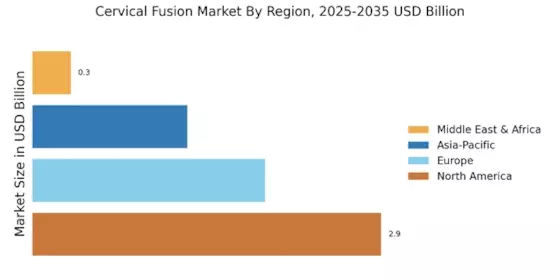Advancements in Surgical Techniques
Innovations in surgical techniques, particularly minimally invasive approaches, are transforming the landscape of the Cervical Fusion Market. These advancements not only enhance patient outcomes but also reduce recovery times, making surgical options more appealing. The introduction of robotic-assisted surgeries and endoscopic techniques has led to a significant increase in the number of procedures performed. Data indicates that minimally invasive cervical fusion surgeries have grown by approximately 30% over the past few years. This shift towards advanced surgical methods is likely to continue, as healthcare providers and patients alike recognize the benefits of reduced trauma and faster rehabilitation associated with these techniques.
Rising Incidence of Cervical Disorders
The increasing prevalence of cervical disorders, such as herniated discs and degenerative disc disease, is a primary driver of the Cervical Fusion Market. As the population ages, the incidence of these conditions tends to rise, leading to a greater demand for surgical interventions. According to recent data, cervical spine surgeries have seen a notable increase, with estimates suggesting that over 500,000 procedures are performed annually. This trend indicates a growing need for effective treatment options, thereby propelling the market forward. Furthermore, the rising awareness among patients regarding treatment options contributes to the demand for cervical fusion procedures, as individuals seek solutions to alleviate chronic pain and improve quality of life.
Growing Awareness and Education on Spine Health
The rising awareness regarding spine health and the importance of early intervention for cervical disorders is significantly influencing the Cervical Fusion Market. Educational campaigns and initiatives by healthcare organizations are informing the public about the risks associated with untreated cervical conditions. This heightened awareness is leading to earlier diagnoses and increased patient consultations, which in turn drives the demand for surgical options. Recent surveys indicate that nearly 60% of individuals are now more informed about spine health compared to previous years. As patients become more proactive in seeking treatment, the market for cervical fusion is likely to expand, reflecting a shift towards preventive care.
Technological Integration in Surgical Procedures
The integration of advanced technologies, such as artificial intelligence and augmented reality, into surgical procedures is emerging as a significant driver in the Cervical Fusion Market. These technologies enhance surgical precision and improve outcomes, which is increasingly appealing to both surgeons and patients. The use of AI in preoperative planning and intraoperative navigation is expected to streamline procedures and reduce complications. Market analysis suggests that the adoption of these technologies could lead to a 20% increase in the efficiency of cervical fusion surgeries. As the medical community continues to embrace technological advancements, the demand for cervical fusion procedures is likely to rise, reflecting a broader trend towards innovation in healthcare.
Increased Investment in Healthcare Infrastructure
The expansion of healthcare infrastructure, particularly in developing regions, is a crucial driver for the Cervical Fusion Market. Governments and private entities are investing heavily in healthcare facilities, which enhances access to surgical procedures, including cervical fusion. This investment is expected to lead to a rise in the number of surgical centers equipped with advanced technologies, thereby facilitating more cervical fusion surgeries. Market data suggests that the healthcare expenditure in many regions is projected to grow by 5-7% annually, which will likely support the demand for cervical fusion procedures. As healthcare systems improve, the availability of specialized services will increase, further driving market growth.


















Leave a Comment